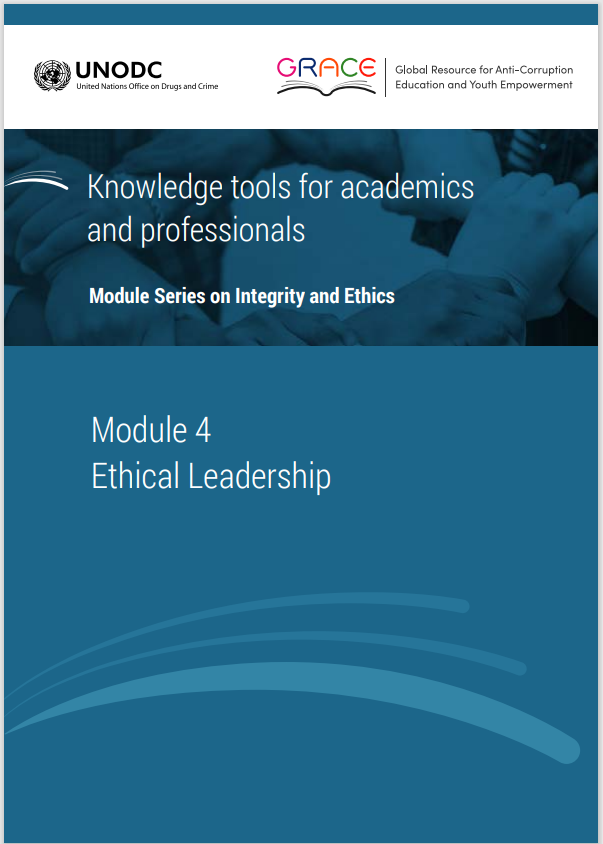This module is a resource for lecturers
Possible class structure
This section contains recommendations for a teaching sequence and timing intended to achieve learning outcomes through a three-hour class. The lecturer may wish to disregard or shorten some of the segments below in order to give more time to other elements, including introduction, icebreakers, conclusion or short breaks. The structure could also be adapted for shorter or longer classes, given that the class durations vary across countries.
Introduction (5 minutes)
- Introduce the importance of leadership given the complexity and cultural variation of organizations worldwide.
- Introduce the three questions to be addressed in the Module: what is ethical leadership, why is ethical leadership important, and how to promote ethical leadership.
Leader's view exercise (20 minutes)
- Conduct exercise 1. Distribute a sheet to every student, and ask students to answer the questions (5 minutes).
- Have students share their answers and reasons behind their choices (10 minutes).
- Summarize the answers and reasons, and explains that the ambiguity and differences discovered in the discussion can be better resolved through obtaining more knowledge about ethical leadership (5 minutes).
Definition of leadership and ethical leadership (5 minutes)
- Present the definitions of leadership, paying special attention to the components central to the phenomenon: (a) leadership is a process, (b) leadership involves influence, (c) leadership occurs in groups, and (d) leadership involves common values and goals.
- Present the definitions of ethical leadership, and briefly explain the differences between ethical leadership and leadership ethics.
Why do leaders have ethical responsibility? (10 minutes)
- Discuss the importance of ethical leadership drawing on the relevant discussion in the Key Issues section of the Module.
- Use both theoretical reasons and real cases, with an emphasis on real cases which are relevant to students in addressing a leader's ethical responsibility.
The importance of ethical leadership for effective leadership (25 minutes)
- Introduce the 'interpersonal trust' model developed by Schindler and Thomas (2 minutes).
- Facilitate a discussion regarding the importance of ethical leadership for effective leadership based on the interpersonal trust model (10 minutes).
- Introduces the 'social power' model developed by French and Raven (3 minutes).
- Facilitates a discussion regarding the importance of ethical leadership for effective leadership based on the social power model. Pay special attention to the features of individuals, organizations and the contemporary world, and their impacts on the role of ethical leadership as a referent power (10 minutes).
Decision cards exercise (20 minutes)
- Conduct exercise 2. See guidelines in the Exercises section of the Module.
Pop-culture examples of ethical leadership (20 minutes)
- Conduct exercise 3. See guidelines in the Exercises section of the Module.
Case studies (20 minutes)
- Conduct exercise 4 or 5 See guidelines in the Exercises section of the Module.
Applying ethical theories, principle and models to leadership (30 minutes)
- Introduce the main ethical theories of utilitarianism, deontology and virtue, and apply them to the case study (15 minutes).
- Introduce the principles of ethical leadership proposed by Eisenbeiss and Northouse and apply them to the case study (10 minutes).
- Discuss ethical decision-making models and ethics quick tests and apply them to the case study (5 minutes).
Turning knowledge into practice (25 minutes)
- Conduct exercise 6. See guidelines in the Exercises section of the Module.
- Discuss questions such as: Will you add, delete, or modify any items? Why? (10 minutes)
- Discuss virtues leaders ought to possess. The lecturer presents the virtues suggested by thinkers like Aristotle, Confucius, or any others who are influential to the students (5 minutes).
- Discussion on what an ethical manager ought to do to infuse the organization with principles that will guide the actions of all employees and build an ethical organization (10 minutes).
 Next page
Next page
 Back to top
Back to top
